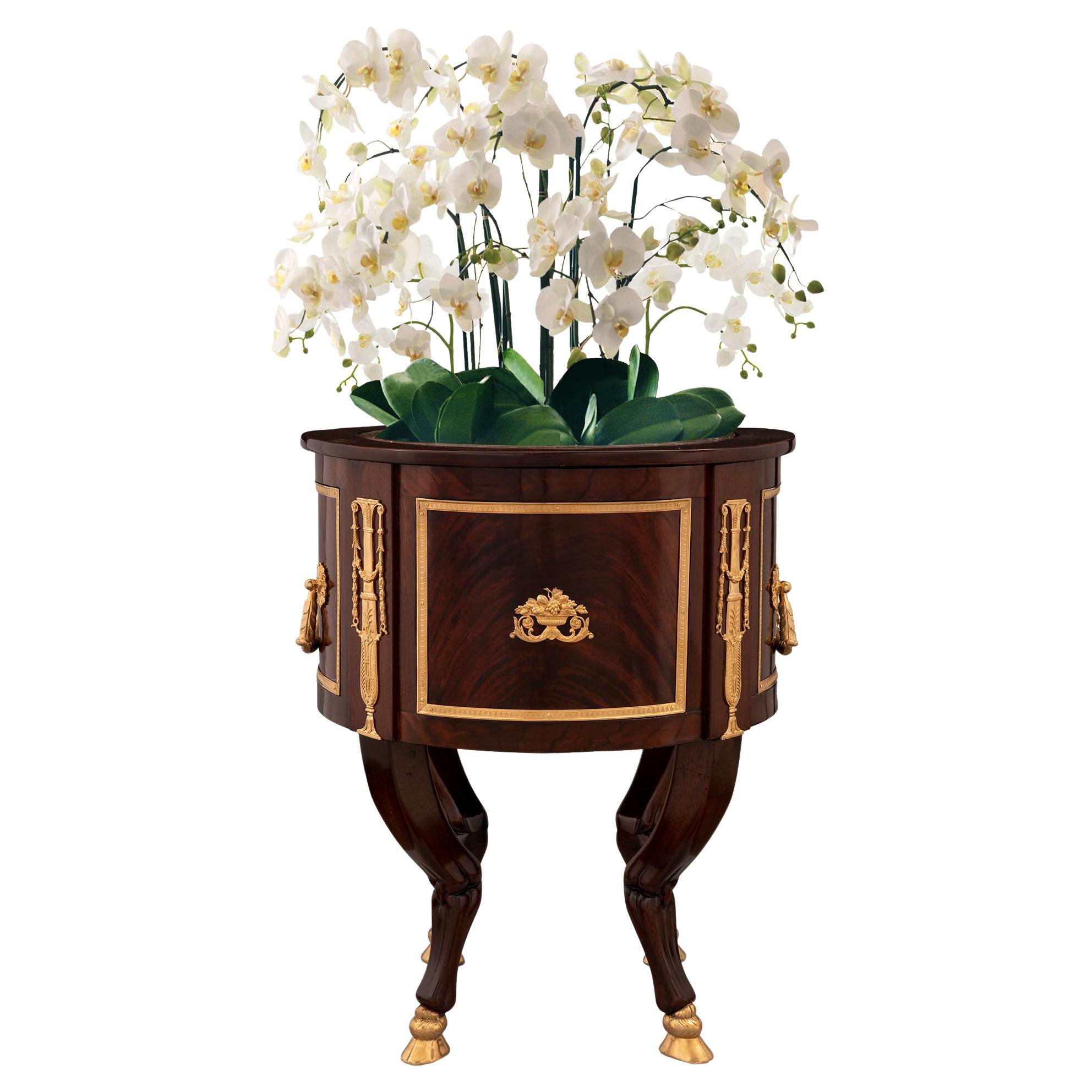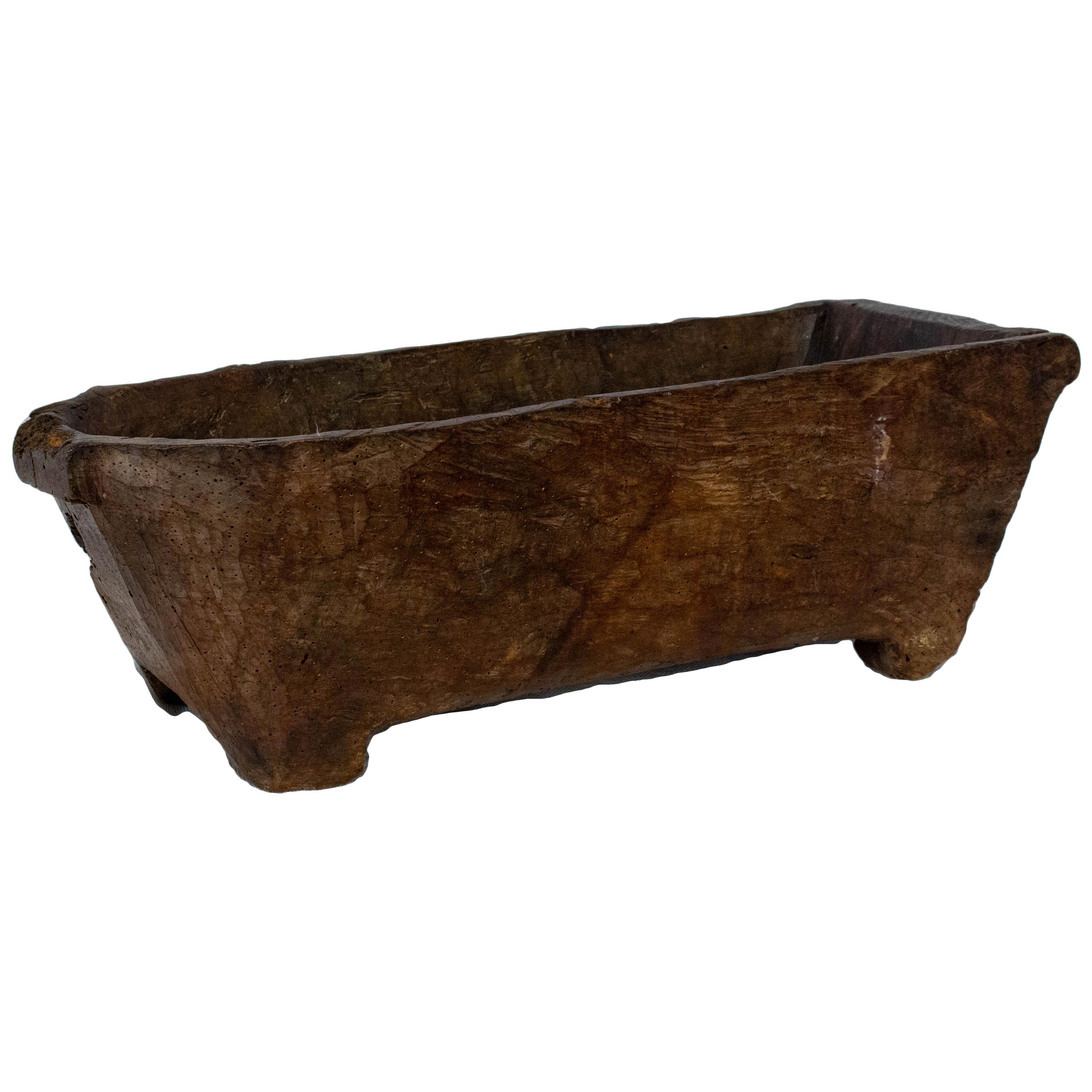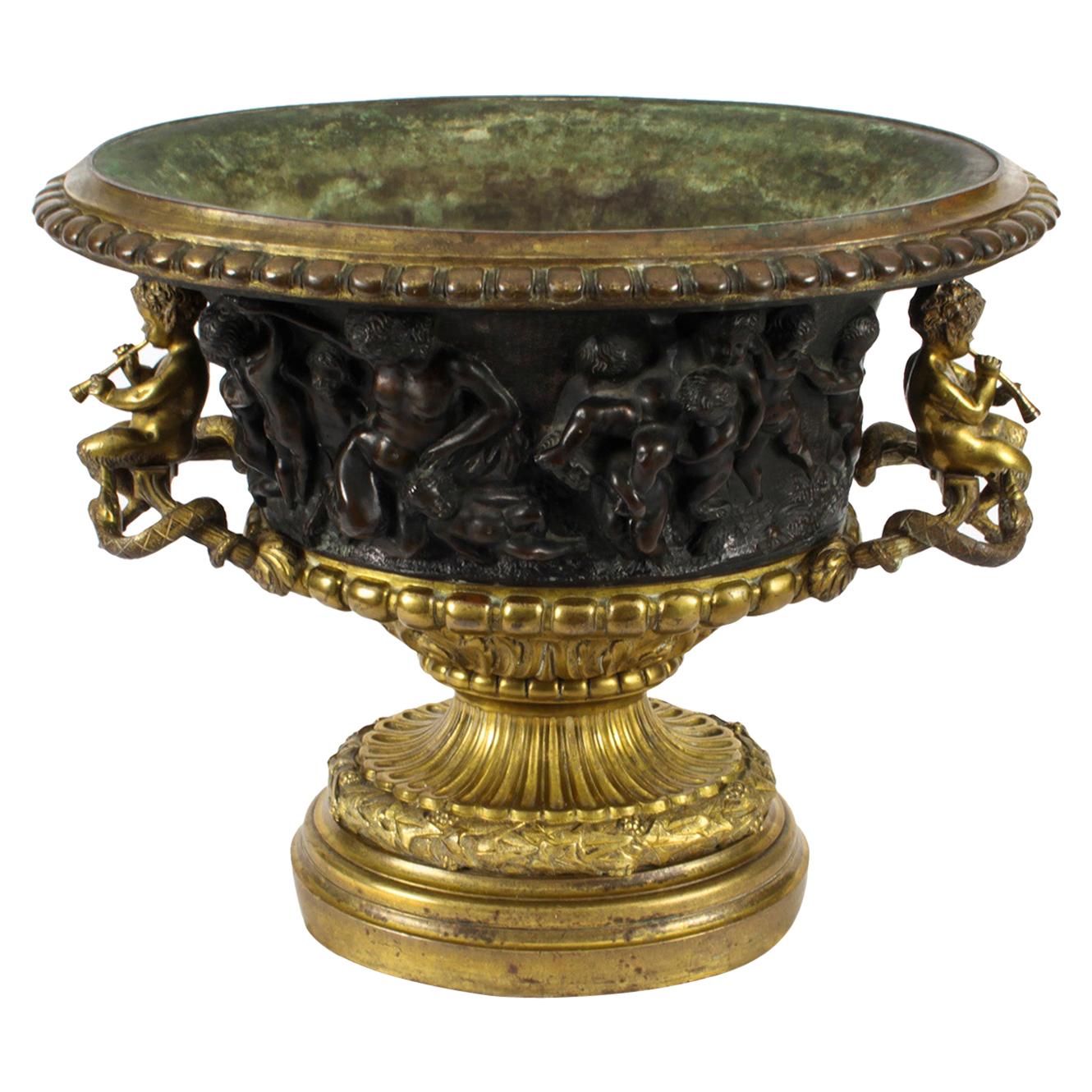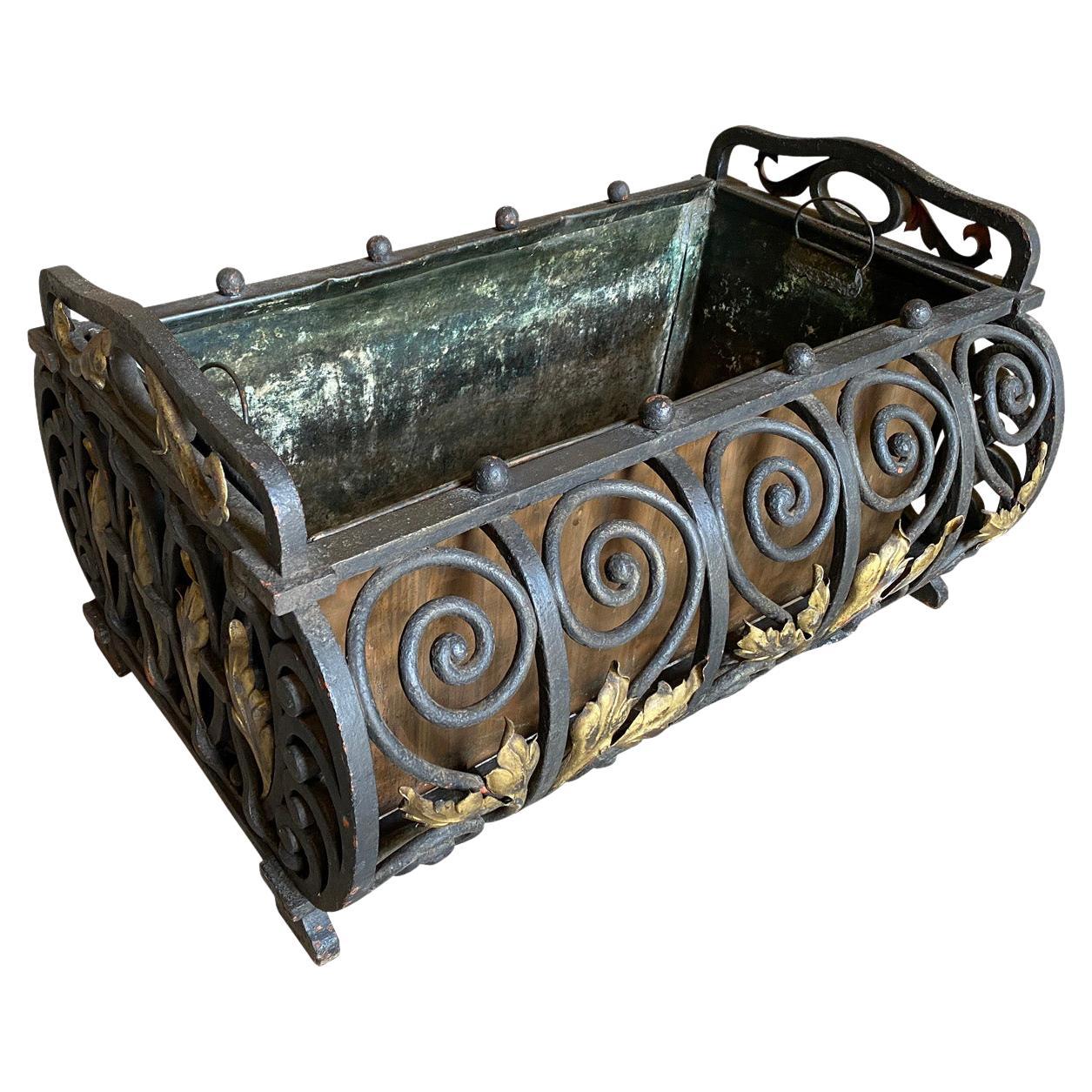Items Similar to Antique French Ormolu Mounted Planter Jardiniere 19th Century
Want more images or videos?
Request additional images or videos from the seller
1 of 11
Antique French Ormolu Mounted Planter Jardiniere 19th Century
About the Item
This is a superb antique French ormolu mounted wood, amboyna and Gonçalo Alves table jardiniere, circa 1860 in date.
This beautiful jardiniere is serpentine in shape with splendid ormolu mounts and pierced ormolu gallery flanked by side handles and a with a lift-out zinc liner.
The craftsmanship and finish are second to none.
Condition:
In really excellent condition having been beautifully cleaned, polished and waxed in our workshops, please see photos for confirmation.
Dimensions in cm:
Height 19 cm x Width 45 cm x Depth 31 cm
Dimensions in inches:
Height 7 inches x Width 1 foot, 6 inches x Depth 1 foot
Ormolu - (from French 'or moulu', signifying ground or pounded gold) is an 18th-century English term for applying finely ground, high-carat gold in a mercury amalgam to an object of bronze.The mercury is driven off in a kiln leaving behind a gold-coloured veneer known as 'gilt bronze'.
The manufacture of true ormolu employs a process known as mercury-gilding or fire-gilding, in which a solution of nitrate of mercury is applied to a piece of copper, brass, or bronze, followed by the application of an amalgam of gold and mercury. The item was then exposed to extreme heat until the mercury burned off and the gold remained, adhered to the metal object.
Wood
is a classic furniture wood, almost exclusively used for inlays on very fine furniture. Occasionally it is used in the solid for small items and turned work, including parts of billiard cues, e.g., those made by John Parris. It is brownish-purple with many fine darker stripes and occasional irregular swirls. Occasionally it contains pale streaks of a similar colour to sapwood.
The wood is very dense and hard and can be brought to a spectacular finish. it turns well but due to its density and hardness can be difficult to work with hand tools. It also has a tendency to blunt the tools due to its abrasive properties.
Amboyna
is a type of wood which has its origins in Indonesia (the preferred veneer comes particularly from the Andaman Islands). The grain texture is one of the most seldom and exclusive on earth.
The burls are often very small, which is why the sheets of veneer come in small dimensions. The colours range from deep yellowish-orange to dark red.
After finishing the surface, the grain texture of amboyna wood has a depth and richness unmatched in other textured woods.
Gonçalo Alves is a hardwood (from the Portuguese name, Gonçalo Alves). It is sometimes referred to as tigerwood — a name that underscore the wood’s often dramatic, contrasting color scheme.
While the sapwood is very light in color, the heartwood is a sombre brown, with dark streaks that give it a unique look. The wood’s color deepens with exposure and age and even the plainer wood has a natural luster.
Two species are usually listed as sources for gonçalo alves: Astronium fraxinifolium and Astronium graveolens, although other species in the genus may yield similar wood; the amount of striping that is present may vary.
In the high tropical forests of Central and South America, well-drained soils furnish nutrients for a variety of dense, durable hardwoods sought for maritime use, heavyconstruction, and furniture. The Spanish began harvesting in Latin American forests in the early 1500s to provide timber for boatbuilding and repair. By the early 1900s, however, steel ships had replaced wooden ones, and the interest in tropical forests by both Europeans and Americans shifted to appearance-grade woods for furniture.
Although history fails to provide us with a shopping list of species from either harvest period, it's probable that the wood we know today as goncalo alves has always been sought. That's because goncalo alves, considered one of the most beautiful of tropical woods, has a tough reputation, too. Strong and durable, it's used for construction in its homeland and secondarily for fine furniture. Woodworkers elsewhere treasure the wood for decorative items and veneer accents.
Our reference: A3824
- Dimensions:Height: 7.49 in (19 cm)Width: 17.72 in (45 cm)Depth: 12.21 in (31 cm)
- Materials and Techniques:
- Place of Origin:
- Period:
- Date of Manufacture:circa 1860
- Condition:
- Seller Location:London, GB
- Reference Number:
About the Seller
5.0
Platinum Seller
These expertly vetted sellers are 1stDibs' most experienced sellers and are rated highest by our customers.
Established in 1983
1stDibs seller since 2012
1,210 sales on 1stDibs
Typical response time: 1 hour
Associations
LAPADA - The Association of Arts & Antiques Dealers
- ShippingRetrieving quote...Ships From: London, United Kingdom
- Return PolicyA return for this item may be initiated within 14 days of delivery.
More From This SellerView All
- Antique French Grand Tour Bronze & Ormolu Jardiniere 19th CLocated in London, GBThis is a beautiful large antique French Grand Tour dark patinated bronze and ormolu jardiniere, Circa 1830 in date. This stunning bronze is superbly cast and has an elegant brown...Category
Antique 1830s French Planters and Jardinieres
MaterialsBronze, Ormolu
- Antique French Sevres Porcelain Ormolu Mounted Planter Jardiniere 19th CenturyLocated in London, GBThis is a superb antique French Louis XV revival ormolu and Sevres porcelain mounted, wood jardiniere, circa 1860 in date. This beautiful shaped planter has splendid ormolu mounts ...Category
Antique 19th Century French Louis XV Pedestals and Columns
MaterialsOrmolu
- Antique French Empire Revival Ormolu Mounted Desk, 19th CenturyLocated in London, GBThis is an exquisite French Empire Revival pedestal desk, circa 1880 in date. This desk has been beautifully crafted from flame mahogany. The top has a striking gold tooled black leather inset writing surface which has a decorative geometric inlaid satinwood and ebony border around it. It features beautifully cast gilded Ormolu mounts including angels, pharaonic herms above paw feet and swan escutcheons. It is further enhanced with male masks wearing nemes headress's on the sides, making it an incredibly imposing and impressive item of furniture. The desk features seven drawers for maximum storage, it is freestanding with a beautifully panelled back and comes complete with the original working locks and keys. This desk will soon become the centrepiece of your furniture collection, there is no mistaking the sophisticated quality and design and it is certain to enhance the style and elegance of any living area, bedroom, or reception. THE BOTANICAL NAME FOR THE MAHOGANY THIS ITEM IS MADE OF IS SWIETENIA MACROPHYLLA AND THIS TYPE OF MAHOGANY IS NOT SUBJECT TO CITES REGULATION. Condition: In excellent condition having been beautifully cleaned, French polished, waxed and releathered in our workshops, please see photos for confirmation. Dimensions in cm: Height 76 x width 150 x depth 80 Dimensions in inches: Height 29.9 x width 59.1 x depth 31.5 Empire style, is an early 19th century design movement in architecture, furniture, other decorative arts, and the visual arts followed in Europe and America until circa 1830. The style originated in and takes its name from the rule of Napoleon I in the First French Empire, where it was intended to idealize Napoleon's leadership and the French state. The style corresponds to the Biedermeier style in the German-speaking lands, Federal style in the United States and to the Regency style in Britain. The previous style was called Louis XVI style, in France. The Empire style was based on aspects of the Roman Empire. It is the second phase of neoclassicism which is also called "Directoire", after a government system. Furniture typically had symbols and ornaments borrowed from the glorious ancient Greek and Roman empires. The furniture was made from heavy woods such as mahogany and ebony, imported from the colonies, with dark finishes often with decorative bronze mounts. Marble tops were popular as were Egyptian motifs like sphinxes, griffins, urns and eagles and the Napoleonic symbols, the eagle, the bee, the initials "I" and a large "N." Gilded bronze (ormolu) details displayed a high level of craftsmanship. Flame mahogany Thomas Sheraton - 18th century furniture designer, once characterized mahogany as "best suited to furniture where strength is demanded as well as a wood that works...Category
Antique 1880s French Empire Revival Desks and Writing Tables
MaterialsOrmolu
- Antique French Ormolu Mounted Vitrine Display Cabinet, 19th CLocated in London, GBThis is a beautiful antique French ormolu mounted mahogany vitrine, circa 1870 in date. This beautiful cabinet is of slender form with gilt bronze ormolu mounts and a moulded cor...Category
Antique 1870s French Cabinets
MaterialsOrmolu
- Antique French Parquetry Ormolu Mounted Vitrine Cabinet 19th CLocated in London, GBThis is a beautiful antique French Louis Revival parquetry and ormolu mounted breakront vitrine, circa 1860 in date. This beautiful cabinet has exquisite parquetry and crossbanded ...Category
Antique 1860s French Cabinets
MaterialsMarble, Ormolu
- Antique Petite French Ormolu Mounted Bureau Plat 19th CLocated in London, GBThis is an fine and beautiful petite French Louis XV Revival goncalo alves and ormolu mounted bureau plat, circa 1850 in date. This fantastic bureau plat features an ornate serpenti...Category
Antique 1850s French Louis XVI Desks and Writing Tables
MaterialsWood
You May Also Like
- French 19th Century Neoclassical Style Mahogany and Ormolu Jardinière PlanterLocated in West Palm Beach, FLA striking and most unique French 19th century neo-classical st. mahogany and ormolu jardinière planter. The planter is raised by impressive gazelle shaped legs with handsome ormolu ...Category
Antique 19th Century French Neoclassical Planters and Jardinieres
MaterialsOrmolu
- Antique 19th-Century French Mahogany Carved Jardiniere PlanterLocated in Pearland, TXA superb 19th century French hand carved mahogany jardiniere or planter with original tin liner. It's a nice large rectangular size, solid and heavy, with very fine carving and bun f...Category
Antique Late 19th Century French Planters and Jardinieres
MaterialsMahogany
- French Early 19th Century Directoire St. Mahogany And Ormolu Jardiniere PlanterLocated in West Palm Beach, FLAn exceptional and most decorative French early 19th century Directoire st. Mahogany and ormolu jardiniere planter circa 1805. The planter is raised by an elegant bottom tier with fi...Category
Antique 19th Century French Directoire Planters and Jardinieres
MaterialsOrmolu
- 19th Century Planter Jardinière Antique Fountain Basin, SW FranceLocated in Labrit, LandesAntique French fountain basin can be used as a planter or jardinière This item also may have served of children bath tub Very old, the wood wor...Category
Antique 19th Century French French Provincial Planters and Jardinieres
MaterialsWood
- French 19th Century Louis XIV Style Jardiniere, PlanterLocated in Atlanta, GAA lovely 19th century French Louis XIV style Jardiniere handsomely crafted from iron with its original copper liner. Perfect for any interior or garden.Category
Antique 19th Century French Planters and Jardinieres
MaterialsCopper, Iron
- 19th Century Japanese Bronze Planters JardinieresLocated in Germantown, MDAntique fine quality Oriental Japanese bronze Jardinière planter bowl Meiji Period, 19th century. Would look amazing in the right location or make a fabulous centre piece. Great c...Category
Mid-20th Century Japanese Meiji Planters and Jardinieres
MaterialsBronze
Recently Viewed
View AllMore Ways To Browse
Antique Ormolu
Antique Classic Furniture
French Ormolu Furniture
French Antique Ormolu Furniture
Ormolu Mounted French
Gold Ormolu
Spanish French Antiques
Gilt Ormolu Mount Furniture
Gilt Ormolu Mount
Gilt Ormolu Mounted Furniture
French Gilt Ormolu Mount
19th Century Ormolu Gilt Mounted
19th Century French Ormolu Gilt Mounted
Antique Ormolu Mounts
Antique French Ormolu Piece
Antique French Ormolu Mounts
French Brass Ormolu
Inlay Ormolu





